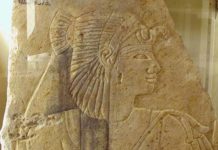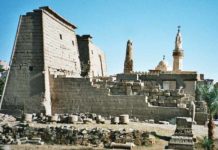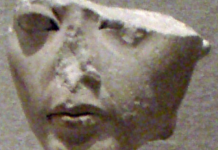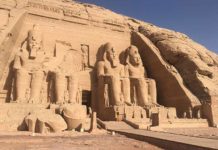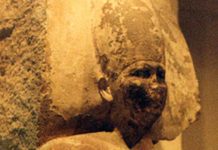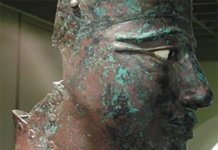The Biblical creation story has often been compared to other ancient creation myths. The influence of other ancient accounts such as the Babylonian Enuma Elish and Atrahasis are generally acknowledged by historians. Perhaps less known is the influence that Egyptian Myths had on the Biblical narrative.
The foundational Egyptian cosmological myth comes from the city of Heliopolis. This myth tells how the creator god created himself and then gradually the entire universe in a series of stages.
Heliopolitian Myth
The well known opening line of the Bible begins with the third stage of the Heliopolitan myth. This makes sense as the Biblical deity pre-exists creation and does not need to self create.
In the beginning God created the heaven and the earth. (Gen: 1, 1)
In the Helioplotan myth first Atum creates himself, and then he creates the Twins, Shu and Tefnut who are male and female aspects of the void. Then they give birth to their children the earth god Geb and the sky-goddess Nut. The creation of earth and sky separates the void from the primeval waters. Atum then manifests in the form of the “Sole Eye” as the Sun-god Re. This begins the first day.
In this myth the first thing, after self-creation, that the creator god Atum does is to create the void which is manifest as the God Shu. In Genesis the void also exists as the second step of creation but follows the creation of earth and sky which is a reversal of the Heliopolitan order.
The division of land from water and from the sky, which is described in Gen 1, 6, is reminiscent of the Heliopolitan notion of primeval waters being the first building blocks of creation in the void.
And God said: ‘Let there be a firmament in the midst of the waters, and let it divide the waters from the waters. (Gen 1, 6)
Memphite Myth
The concept of God creating by speaking was fully developed by the Memphis mythos and this is also the foundation of God’s creative force in chapter 1 of Genesis. The ubiquitous phrase “And God said,” fills the first chapter of Genesis and little happens without God giving a spoken command.
Another example of Memphite influence can be seen In Gen 1, 9 as dry land appears amidst the water.
And God said: ‘Let the waters under the heaven be gathered together unto one place, and let the dry land appear.’ And it was so. (Gen: 1, 9)
This is directly analogous to the Memphite belief that creation could be marked by the emergence of a primeval mound out of the waters of creation.
Hermopolitan Myth
Influence from Hermopolis is evident in Gen, 1, 2.
Now the earth was unformed and void, and darkness was upon the face of the deep; and the spirit of God hovered over the face of the waters. (Gen: 1, 2)
The mention of “void”, “darkness”, “the deep”, and “the waters” in verse two shows an easy synchronization between the Genesis cosmology and the Hermopolitan mythos which defines the four primal forces as flood, waters, darkness, and chaos. Each of these aspects was given a male and female side and together they formed the Ogdoad, or eight gods, of Hermopolis. Here the use of void in place of chaos is easily understood when the influence Shu from the older Heliopolitan cosmology is considered.
In an interesting twist, the use of “deep” instead of “flood” is likely due to a deliberate rejection of the Babylonian creation myth and its personification of the deep as the goddess Tiamat. The Biblical writers used tehôm which is a non-personified cognate of Tiamat. Nevertheless the basic Ogdoad design remains.
Amun And Jehovah
The Theban Cosmology, which identifies Amun as the creator god, also shares important features with the Genesis creation account. In both myths the creator is transcendent of creation and stands apart from it. This is a significant evolution over earlier models like the Heliopolitan and Memphite myths which allow for a god who created himself as the first act of creation.
The connection between Amun and the God in Genesis is also evident in chapter two which begins the use of the term “Lord God.” In this case Lord is translated from the Hebrew proper name for God, Jehovah. Jehovah can be understood as “he who exists,” which is not dissimilar to Amun’s appellation, “he who is hidden.” Both names imply a god forever beyond the comprehension of his worshipers.
The Aten
Although the Aten religion was short lived in Egypt (ca. 1350-1330 BCE) its influence, may have impacted the Old Testament writers. This religion took the idea of a remote and solitary deity to an extreme, doing away with any mythology altogether. The Bible is only one example of evidence showing that the idea of a hidden god, removed from the world of humans, remained alive well after the end of Atenism.
How manifold it is, what thou hast made!
They (the aspects of creation) are hidden from the face (of man).
O sole god, like whom there is no other!
Thou didst create the world according to thy desire,
Whilst thou wert alone: All men, cattle, and wild beasts,
Whatever is on earth, going upon (its) feet,
And what is on high, flying with its wings.
(Great Hymn to the Aten)
The ultimate power granted to the Biblical deity is similar of the power granted to the Aten which even more clearly then Amun, pre-existed and stood apart from creation. As explained in the “Great Hymn to the Aten” the Aten does not even need to speak, it merely manifests creation according to its desire.



